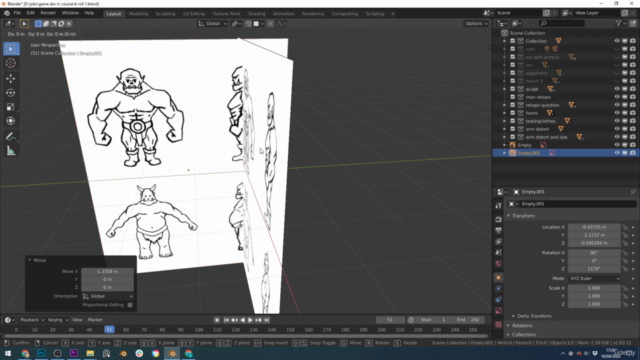

#MAKE A QUICK CHARACTER FROM PHOTO BLENDER MOD#
Blender does the rest (linked=False, mode="TRANSLATION") (target="MESH") shapeInstances.append(_object) = shape_key.name _all(action="DESELECT") obj.select_set(state=True) context.view_ = obj shape_key.value = 0.0 i = i + 1 context.view_ = obj # create final object (linked=False, mode="TRANSLATION") newobj = _object newobj.name = obj.name + "_APPLIED" # clear all old shapekeys from new object newobj.shape_key_clear() # apply all modifiers on new object for mod in newobj.modifiers: if mod.name != "Armature": _apply(apply_as='DATA', modifier=mod.name) # iterate all temporary saved shapekey objects, select only that and the final object and join them for shapeInstance in shapeInstances: _all(action="DESELECT") lect_set(state=True) lect_set(state=True) context.view_ = newobj result = _shapes() # reset old shape key values i = 0 for shape_key in _keys.key_blocks: if i != 0: shape_key.value = shapeValues i = i + 1 # reset old shape key values i = 0 for shape_key in _keys.key_blocks: if i != 0: shape_key.value = shapeValues i = i + 1 # delete temporary objects _all(action="DESELECT") for shapeInstance in shapeInstances: lect_set(state=True) (use_global=False) # redeactivate armature modifiers for mod in obj.modifiers: if mod.type = 'ARMATURE': _viewport = True for mod in newobj.modifiers: if mod.type = 'ARMATURE': _viewport = True return Will set to 0 temporarily shapeValues.append(shape_key.value) shape_key.value = 0.0 i = 0 for shape_key in _keys.key_blocks: # ignore basis shapekey if i != 0: # make sure only relevant object is selected and active _all(action="DESELECT") obj.select_set(state=True) context.view_ = obj # make sure only this shape key is set to 1 shape_key.value = 1.0 # duplicate object with only one shape key active. Next, open a text editor, save the following script in an appropriate location, and call it apply_with_shape_keys.py: import bpy class ApplyWithShapeKeys(): """Tooltip""" bl_idname = "object.applywithshapekeys" bl_label = "Apply Modifiers With Shapekeys" def execute(self, context): selection = _objects for obj in selection: if obj.type = "MESH": # lists store temporary objects created from shapekeys shapeInstances = shapeValues = # Deactivate any armature modifiers for mod in obj.modifiers: if mod.type = 'ARMATURE': _viewport = False for shape_key in _keys.key_blocks: # save old shapekey value to restore later.

After some extensive Googling, I came across this very useful thread that contains a script for exactly what we need (big thanks to MorphCider). Otherwise, the shape keys will not be retained when exporting the character - which means no animations will work. This might be faster than modeling from scratch, and the results will definitely be higher quality than the quick/hacky method described above.The subdivision modifier is slightly more tricky and requires a Python script to work.
#MAKE A QUICK CHARACTER FROM PHOTO BLENDER FREE#
Now you can clean up the texture using texture paint, taking advantage of the cloning brush, for example, to copy colors and textures from other parts of the mesh.Ī different idea: the free MakeHuman program seems to be designed specifically to assist in making human figures (meshes and armatures) that match a reference image. How do I bake a texture using Cycles bake Don't forget to save your baked texture externally. Then bake the colors of your first mesh to the texture in your second mesh using "bake selected to active." I'm not going to go through all the steps here because that process is covered elsewhere. You also need to re-unwrap the duplicate person mesh to something where the faces do not overlap - you could use "smart UV project", the neatness of the unwrap isn't very important. Give the new mesh a new material, and in this material add a new image texture (not connected to any shaders) that will receive the baked colors. The sides will be distorted and the back will just be a mirror of the front, you'll fix that later (at least, the parts that will be seen). Use that image as the diffuse color of your person mesh, and because of the unwrapping from the camera perspective it should look correct. Then position the uv faces so the mesh silhouette directly overlaps the human silhouette in the image you're working from. To do this, I would first unwrap your person mesh with a "project from view" unwrapping looking from the camera view. Here is an extraordinarily primitve demonstration of the concept (I didn't even use a human mesh, just a cube extruded into a vaguely human shape): I don't know if you have a high resolution version of your image but with the one you posted there's not a lot of detail to work with, you'd have to put in a bit of effort to get it to look halfway decent.

First, regarding the camera movement, you could bake the image onto your mesh using a couple of different UV unwrappings, then tidy up the colors using texture paint.


 0 kommentar(er)
0 kommentar(er)
